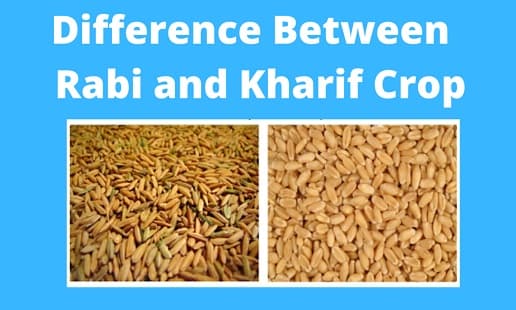India is a place where crops change dependent on the season, they need appropriate climatic conditions to flourish. As per the weather, we may notice a huge difference between Rabi & Kharif crops.
Kharif & Rabi are 2 crops utilized by several Asian nations in the monsoon. While the planting season for the Kharif crop starts with the onset of the monsoon and terminates when it ends. Rabi crops, on the other side, are grown in the winter.
Kharif crops need hot, humid weather, whereas Rabi crops prefer cool, dry weather. This article will provide further examples to illustrate the distinctions between Rabi & Kharif crops.
Rabi Crops
Rabi crops, also known as winter crops, are planted during the colder months of the year, namely between October and December. This harvest takes place in the summer, between April and June.
The states of Haryana, Punjab, Himachal Pradesh, Jammu & Kashmir, Uttarakhand, and Uttar Pradesh are major producers of rabi crops in the country’s north and northwestern regions.
Kharif Crops
Kharif crops are also known as monsoon crops since they are sown during the rainy season (June–August) and harvested in the fall (September–October). Assam, West Bengal, the coastal districts of Odisha, Telangana, Andhra Pradesh, Tamil Nadu, Telangana, Kerala, and Maharashtra are major producers of rice during the Kharif season.
Difference between Kharif crops and Rabi crops
| Aspect | Rabi Crops | Kharif Crops |
| Season | Grown during the winter season | Grown during the monsoon/rainy season |
| Sowing Time | Sown in October to December | Sown in June to July |
| Harvest Time | Harvested in April to June | Harvested in September to October |
| Water Source | Mostly rely on irrigation | Depend on rainfall and natural water |
| Examples | Wheat, barley, peas, mustard, etc. | Rice, maize, sorghum, cotton, soybean, etc. |
| Day Length | Require shorter day length | Thrive in longer day length |
| Climate | Grown in cooler and drier conditions | Grown in warm and humid conditions |
| Temperature | Tolerate colder temperatures | Require higher temperatures |
| Crop Rotation | Often used in crop rotation systems | Less frequently used in rotations |
| Storage | Generally better storage due to lower humidity | Storage may be more challenging due to higher humidity |
| Pests and Diseases | Generally face fewer pest and disease problems | More susceptible to pests and diseases due to higher humidity |

Meaning
Kharif crops– Kharif crops are those that are typically seeded at the start of the rainy season.
Rabi crops– Rabi crops are those that are planted in the wintertime after the monsoon has ended.
Major crops
Kharif crops– Bajra, Jowar, Groundnut, cotton, maize, rice, etc.
Rabi crops– Barley, oilseeds, gram, peas, wheat, etc
Requirement
Kharif crops– Extreme heat and water are necessary for its growth.
Rabi crops– Climates that are warm enough for seed germination yet cold enough for growth are needed.
Flowering
Kharif crops– Requires less day length
Rabi crops– Needs a longer day length
Sowing month
Kharif crops– June-July
Rabi crops– October-November
Harvesting month
Kharif crops– September-October
Rabi crops– March- April
Definition of Kharif crops
Kharif crops, often called monsoon crops, are those cultivated in Asia during the wet months of the year (June through September). The first rains from the southwest monsoon signal the start of the planting season for these crops. When and how much rain falls during the Kharif season are crucial elements in crop yield. Paddy, maize, groundnut, pulses, turmeric, sugarcane, groundnut, cotton, bajra, etc
Since the monsoon’s reach varies from state to state in India, the planting season may begin as early as April or as late as May. The crop is often planted in the southern states (Kerala, Tamil Nadu, etc.) and then moves northward. Due to the colder climate, the northern states often plant their Kharif crops in late June.
Definition of Rabi crops
In Arabic, the word Rabi denotes springtime. In South Asian nations like India, Bangladesh, Pakistan, etc., Rabi crops are sown at the start of winter and harvested in the spring. These are planted after the monsoon season has ended in the nation, often in late October –.early November
Because of the dry weather, rabi crops need to be watered regularly to flourish throughout their growing season. Wheat, gram pea, oat, barley, onion, potato, tomato, and numerous seed crops including coriander, cumin, linseed, rapeseed, sunflower, mustard, etc are the primary crops grown during rabi.
Key differences between Rabi and Kharif crops
Here are some key distinctions between Kharif & rabi harvests:
- Kharif crops are those that are planted in South Asian nations as the rainy season begins. As a counterpoint, winter crops, or Rabi crops, are planted after the rainy season ends.
- When growing, rabi crops prefer cooler temperatures and need warm weather for seed germination, whereas Kharif crops demand more water and warmer temperatures.
- Kharif crops need hot, rainy weather and shorter days for blooming throughout their growing period. On the other hand, greater day length and lower humidity are beneficial for the blossoming of rabi crops.
- Kharif planting occurs in June and July. In contrast, rabi planting season often begins in the fall, between October and November.
- Harvest time for Kharif crops is in September and October. In contrast, Rabi crops are at their peak harvestability in March and April.
Conclusion
The terms Kharif & Rabi crops are used largely to indicate when seeds should be planted and when they should be harvested. Zaid crops, which are cultivated throughout the summer months (March through June), complement these two winter crops.
These crops are grown for a brief time, in the transition between the Rabi and Kharif seasons. Cucumber, bitter gourd, muskmelon, watermelon, etc. are all examples.
Santosh Kumar, the author behind IndiasStuffs.com, is passionate about sharing valuable insights on a variety of topics, including lifestyle, technology, and Indian culture.
Page Contents

